First Steps
How do I create a new gallery?
There are several ways to create a new gallery:
In your browser
Click on "Create New Gallery" in your gallery overview, enter the preferred name of your new gallery and click on "Create gallery" or press ENTER. You will automatically be taken to the new gallery and you can start uploading your first files.
Lightroom
Important info about the Lightroom plugin.
Upload via Lightroom is automatically enabled for picdrop accounts registered before June 2022. If your account was created after June 2022, you won't find the plugin in your account settings. But don't worry: if you can't do without the Lightroom plugin for your work, please email us at hello@picdrop.com and we'll be happy to help.
FTP access
only for accounts created before June 2022
In your FTP program, log into your picdrop FTP account and create a folder. Ready! The gallery is created with it and you can upload files to the gallery at any time via FTP, Lightroom or in your browser.
Don't forget your gallery settings!
For all three ways, you should remember to check the gallery settings afterwards and if necessary set what your client is allowed to see and do in the gallery.
Link to this entryHow to upload my first files?
After you've signed up for your free picdrop account there are many ways to upload your files to picdrop:
Drag & Drop
Simply mark the files you want to upload in Apple Finder or Windows Explorer and drag them anywhere in your open gallery. (No need to drag them on the hint field for the "Drag & Drop" upload.) Then release your mouse button. Your upload starts immediately without you having to do anything else. You can check the status of your upload on the bottom right.
Use the upload button
In the hint field for the "Drag & Drop" upload you will also find a classic upload button (yellow). By clicking on it, you can search in your Finder or Explorer and also select several files at the same time.
Via FTP
only for accounts created before June 2022
You can also manage and organize your galleries and files via FTP. You will find the login data in your registration mail and instructions on how to set up your FTP program in the FAQ section "How do I set up my FTP program correctly?"
Lightroom export
Important info about the Lightroom plugin
Upload via Lightroom is automatically enabled for picdrop accounts registered before June 2022. If your account was created after June 2022, you won't find the plugin in your account settings. But don't worry: if you can't do without the Lightroom plugin for your work, please email us at hello@picdrop.com and we'll be happy to help.
Link to this entryHow do my clients get to their galleries? Do they need an account?
Your clients do not need an account to enter a picdrop gallery.
You simply send your clients the direct URL to a gallery. They then do not need to create an account or anything to open the gallery.
If you have activated the password protection for the gallery, all they have to do is to enter their password and they'll find themselves right in the gallery, ready to view their pictures.
To send this information to your clients you can easily use email, any messenger or the like - or conveniently send it from within picdrop by using the “Share”-option within every gallery.
It's as easy as that!
Link to this entryHow do I set the functions and look for a gallery?
In each of your galleries, you can activate or deactivate all functions individually. You can tailor your galleries perfectly to every client and every project. You are able to do this in each gallery in the upper right corner under “Gallery Settings”.
General settings
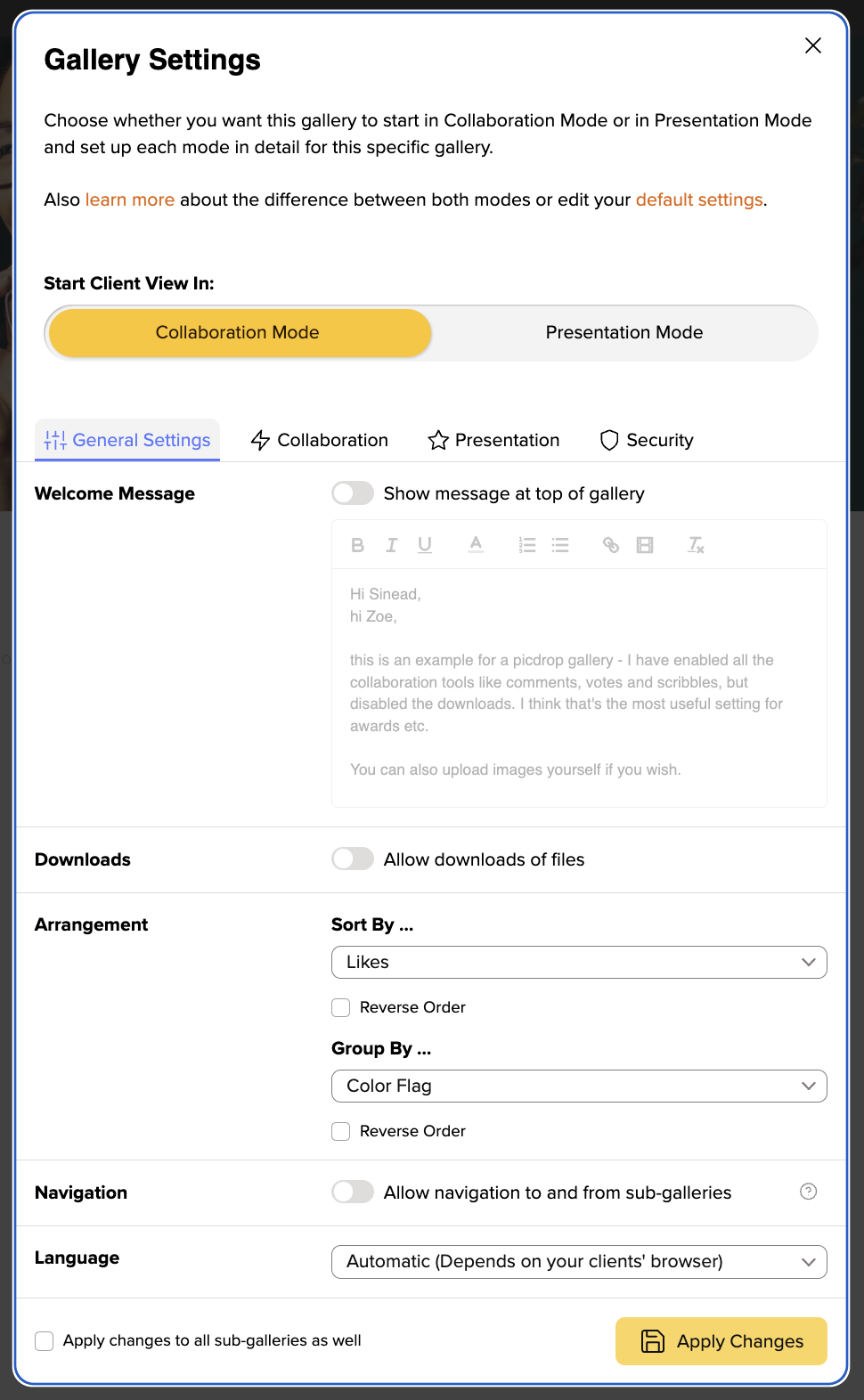
Welcome Message: Here you can welcome your clients to their picdrop gallery or give them specific instructions along the way. The text will always be displayed on top of the gallery.
Downloads: Here you can specify whether your clients may or may not download your original files.
Arrangement: Here you select how your files will be sorted: by file name, capture time, upload time, file type, file size, and image dimensions. You can also group all images by color flags or file type.
You can also decide if your clients should be able to navigate to sub-galleries and vice versa.
picdrop is available in English and German, here you can define in which language your clients should see picdrop. If you do not set anything, picdrop automatically detects the browser language of your clients and then displays the gallery in German or in English.
If you want to change the header image you can find detailed instructions right here.
Collaboration Mode
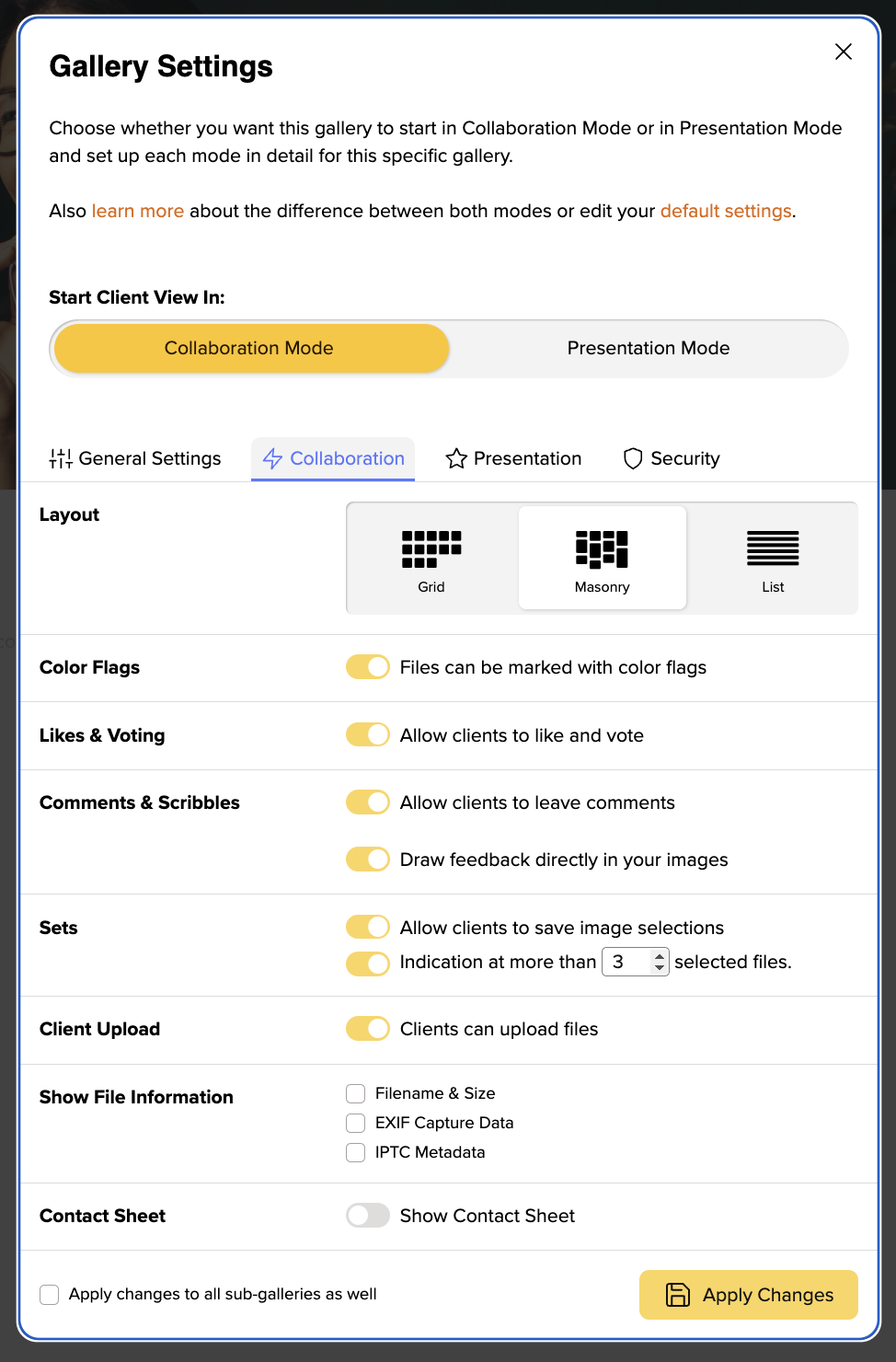
picdrop’s Collaboration Mode is for collaborating and communicating with your clients. Here you can decide what your clients can do.
Layout: Here you define the appearance of your gallery and how your files should be arranged.
File information: Choose what your clients can see when clicking on a single file.
Sets: With the set function you can set specific photos in a gallery. With a click on the blue + at the upper left edge of the preview picture, the file is added to a set. After completing a set, it must be saved and named.
Color flags: Color flags allow you to quickly and easily make assessments and decisions with your clients. You can find the color flags in two places: at the top right of the small preview images in the gallery and in the large single image display directly below the image. Click to open the color flag menu. Here you can choose from the colors red = no, orange = maybe, green = yes and black = FINAL. You can also customize the names for the color flags.
(Pro-Tip: Sort the images in the “Appearance” area by color markers and downwards. This automatically sorts your images in the overview according to color and displays them separately, which makes it extremely easy to filter out favorites.)
Comments: By activating the comments your clients have the possibility to write comments on each file in the gallery. The comments will be displayed at the bottom left of the files and can be created in the same place.
Image annotations: Scribbles let your clients draw their comments into the images.
Client upload: If you want your clients to upload files to the gallery as easily as you can, then activate the client upload.
Print contact sheet: For further coordination, you can also activate the option for your clients to print a contact sheet.
Presentation Mode

The Presentation Mode is a specific way for you to deliver a gallery to your clients. It focuses on the beautiful presentation of your pictures and videos and puts the practical picdrop functions in the background. The Presentation Mode is available for you in some plans (starting with Pro). All features of the Presentation Mode are also available in detail in our FAQ.
Starting the gallery in Presentation Mode: The essential setting for the Presentation Mode is its activation/deactivation.
Since some of the familiar picdrop functions are not active in the Presentation Mode, if you would still like to use these functions with your clients, you should activate the switch to Edit Mode. You can apply this change by entering a 4-6 digit PIN number.
You can hide red marked images / videos in the Presentation Mode from the gallery, so you can only present the best results.
Below these three functions, you find are all the settings with which you can customize the appearance of the gallery in Presentation Mode: being background color, appearance of the header image, as well as size, spacing and edges of your thumbnails. All other gallery components such as buttons and social links conveniently adapt to your settings for the appearance of the gallery.
You can find more detailed information in our separate FAQ articles about gallery design, background color, title settings, setting a gallery’s header imgage and thumbnail settings.
Security
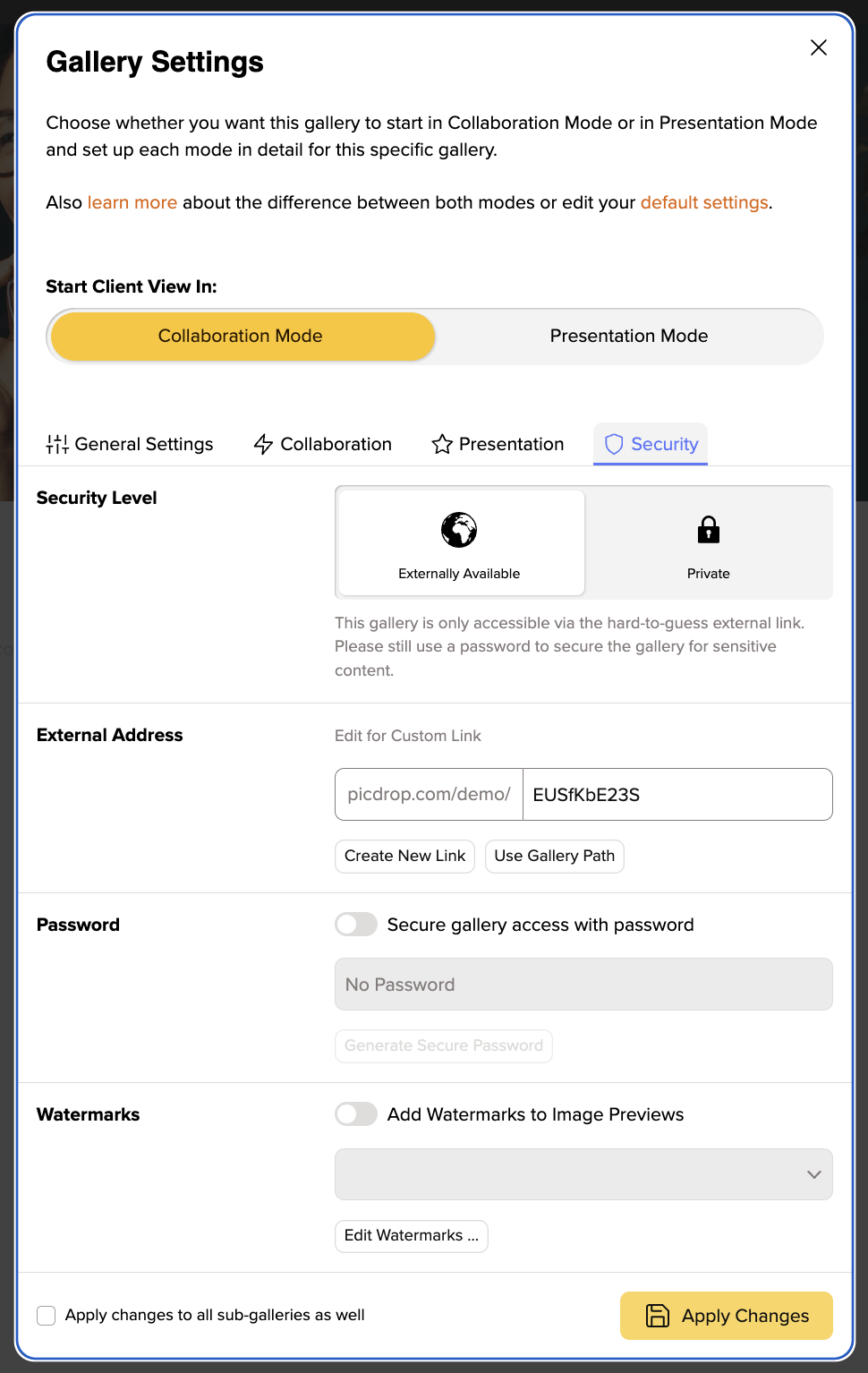
Here you are able to protect your pictures with a watermark and password. But above all, you can specify the address at which your gallery should be accessible.
Gallery Links: There are several ways your gallery links can look. For each gallery, we always create an externally available, secure link first, which consists of a randomly generated string of letters and numbers. In addition, you have the opportunity to edit the link individually and enter the wording that you would like to use for the custom link to the gallery instead of using the random string. By clicking on the "Insert gallery path as custom link" button, you can also select the gallery name and gallery path as link wording. If you set your gallery as private, it will only be visible to you as an account owner and to client logins.
Password: Regardless of the shape of the gallery link, you can create or have an additional gallery password created for each gallery. We generally recommend this additional step to secure the gallery to all our users.
Watermark: To protect your pictures, you can activate the picdrop watermark function. For this purpose, enter one or more desired watermarks in your account settings, for example with your logo. These can then be selected in the gallery settings.
Please note: Activating and disabling watermarks for a gallery can take some time. Please be patient while the function is applied before making any other adjustments to the gallery settings. It is also important to know that we do not overwrite the watermarks on your original pictures since we will never change your files. Instead, we put the watermark over the thumbnails so they are protected from screenshots. Even though watermarks are enabled, the original files can be downloaded. Make sure to deselect download as a function in the gallery settings.
Don’t forget to save!
If you have set everything, you can save your settings by clicking on “Apply Changes“. To make sure that your clients gets exactly the settings you expect, select “Client View” in the top right corner to see how your clients will see the gallery!
Link to this entryHow do I change the order of my images & videos?
You can define the criteria by which your files are sorted and grouped in each gallery. You can do this in the gallery settings under "Genera Settingsl".
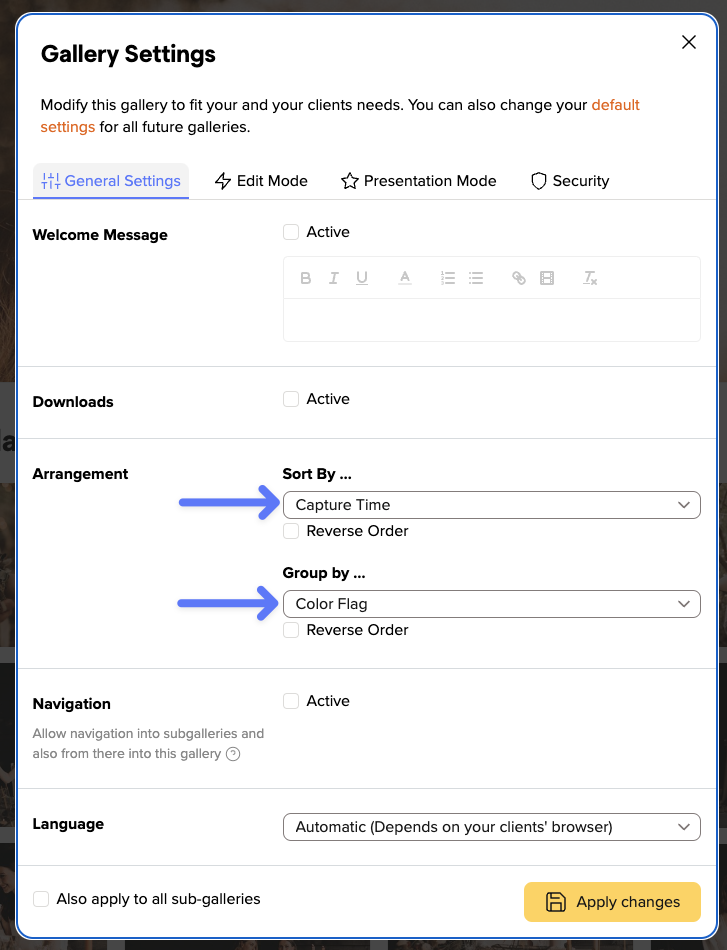
You can sort your files by the following criteria:
File name
Capture time
Time of upload
File size
Image dimensions
In order to be able to sort images according to the time they were taken, this information must be stored in the Exif data of your images.
You can also group files in your gallery. They will then be displayed in the gallery in individual sections.
You can group your files by these attributes:
Color flag
File type
For example, all files marked with the green color flag will be displayed in a separate section. Within this section they will be sorted according to your desired settings.
Each sorting and grouping can also be displayed in reverse order (e.g. files sorted by file name from Z to A instead of from A to Z) by activating "Reverse order".
How can I see what's happening in my galleries?
In your picdrop account you will always find the Activities in the top right-hand corner so you can see what is happening in your galleries at any time.
The red number indicates that there is news in your account.
In the Activities you will find
all visits
all uploads and downloads
information on updated (= re-uploaded) files
Comments and Scribbles
new and changed Color Flags
changes to Selections / Sets
new and changed Likes
the creation date (at the bottom)
in your galleries.
No matter where you are currently working in your account, when you call up the Activities, you will always see the events for all your galleries.
If you are in a gallery, you can restrict the display to the current gallery using the button at the top right ("Show current gallery only").
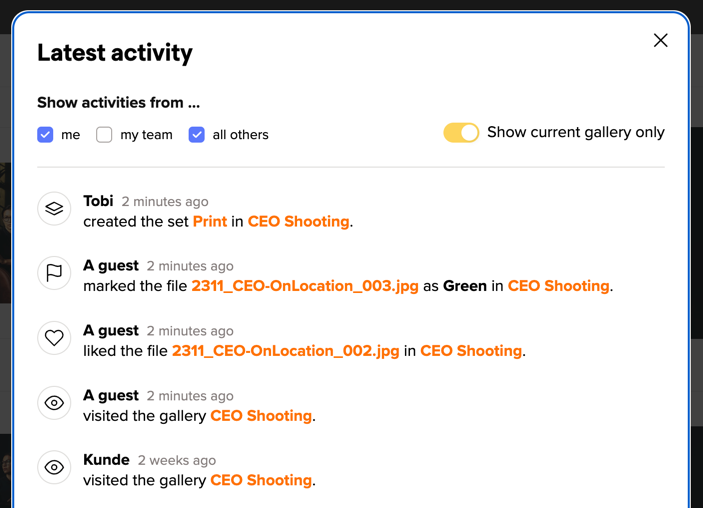
With the three options to the left, you can specify whose actions you want to see: all your own actions, actions from your Team Members or actions from all other visitors to your gallery. You can combine these filters as you wish to get the overview you need.
Two more practical tips:
In your own actions, for example, you can find the upload dates for each image and track the creation date of the gallery.
Move the mouse over the relative date displayed (e.g. yesterday, 2 weeks ago) and you will see the exact time for the event.
The Activities will keep you updated about what’s happening in your galleries. You can also get notifications via email for some of those Activities.
Link to this entry